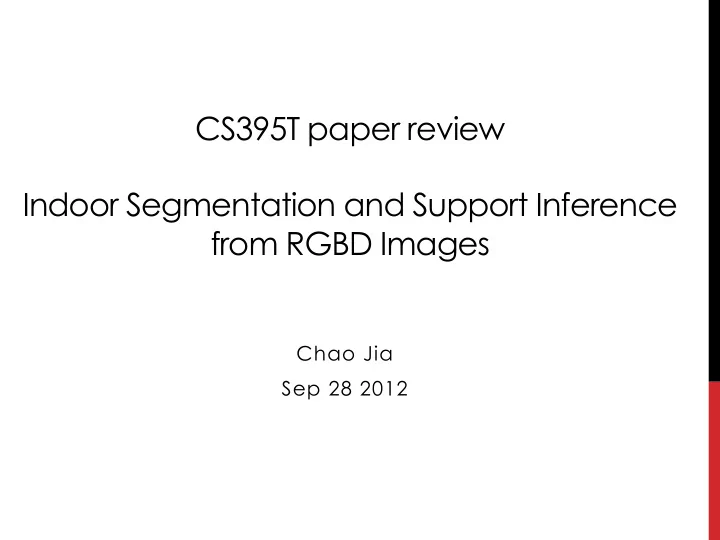

CS395T paper review Indoor Segmentation and Support Inference from RGBD Images ¡ Chao Jia Sep 28 2012
Introduction ¡ What do we want -- Indoor scene parsing • Segmentation and labeling • Support relationships • Different colors show different kinds of objects; Support relationships help understand the scene and interact with scene elements.
Introduction ¡ What do we have • Color image Depth image (3D coordinates) • • How 3D cues can best inform a structured 3D interpretation • Dataset with 1449 densely labeled images •
scene structure region segmentation supporting relationships General Steps ¡ Integer programming How 3D cues help formulation scene interpretation
scene structure region segmentation supporting relationships Scene Structure Modeling ¡ Align the room with the 3 principle directions • Compute 3D lines and surface normals • Find the most probable X-Y-Z axis • Segment the visible regions into 3D planes • Propose 3D planes using RANSAC • Segment the image into the proposed planes •
scene structure region segmentation supporting relationships Aligning to Room Coordinates Preparation using 3D coordinates • Straight line segments • 3D surface normals at each pixel • Propose candidates (100-200) • All the straight 3D lines • Mean-shift modes of surface normals • Manhattan Search for the most probable X-Y-Z triple • world assumption Random sample a triple, compute the score • Choose the triple with highest score • Warp the image to align with principle directions •
scene structure region segmentation supporting relationships Proposing and Segmenting Planes ¡ Generating potential planes • Sample the grid of pixel and propose planes (>2500 inliers) • Assign each pixel a label to a certain plane • Latent variables to infer: plane label • Observable variables: 3D coordinates, RGB intensities, • surface normals Conditional random field modeling solved by graph cuts • pairwise term unary term 3D coordinates surface normals RGB intensities
scene structure region segmentation supporting relationships Proposing and Segmenting Planes ¡ Unary term • Geometrically validate the labels • _ from RANSAC plane proposing Pairwise term • smoothness weighed by RGB intensity difference
scene structure region segmentation supporting relationships Segmentation ¡ Oversegmentation into superpixels • Boundaries detection from RGB intensities • Force consistency with 3D planes regions • Iterative merging of regions • Regions with minimum boundary strength are merged • Boundary strength: • Trained boosted decision tree classifier • y: labels of regions • x: paired regions features •
scene structure region segmentation supporting relationships Segmentation ¡ Paired region features • RGB features : crucial for nearby or touching objects • 3D features (plane labels, surface normals, depth) : • help differentiate between texture and object edges
scene structure region segmentation supporting relationships Modeling Support Relationships ¡ Variables to infer for each region ( R regions in total) • the support region • not supported supported by supported by an (ground) other regions invisible region supported from below/behind • structure class • 1: Ground • 2: Furniture (large objects that cannot be carried) • 3: Prop (small objects that can be easily carried) • 4: Structure (walls, ceiling, columns) •
scene structure region segmentation supporting relationships Modeling Support Relationships ¡ Energy minimization • Factorize posterior distribution • likelihood + Prior factorization Final problem • likelihood + factorization Prior
scene structure region segmentation supporting relationships Modeling Support Relationships ¡ Prior term • Transition prior (supporting relationship between two structure classes) • which combination is more likely Support consistency (between 3D structure and support relationship) • Global ground consistency • Everything is above floor Ground consistency • No support for floor
scene structure region segmentation supporting relationships Modeling Support Relationships ¡ Likelihood term • support relation classifier structure classifier support features • proximity, containment, characteristics of supporting objects, absolute 3D locations of candidate objects structure features • SIFT features, color histogram, … (object classification) • Classifiers trained by logistic regression
scene structure region segmentation supporting relationships Modeling Support Relationships ¡ Introduce Boolean indicator variables: • Problem is linearized ! • Integer programming à relax the integrality constraints •
Experiments ¡ Segmentation evaluation • measured as average overlap over ground truth • regions for best-matching segmented region
Support Relationships Evaluation ¡ Evaluate proposed inference model against • Image plane rules • (no structure class assignment) Structure class rules • (class assignment by trained classifier) Support classifier • (no structure class assignment; infer the support relationship between every pair of regions) Metric • Percentage of correct supports •
Support Relationships Evaluation ¡
Experiments ¡ Structure class prediction evaluation • only slightly better than local classification •
More results ¡ Using ground-truth segmentation •
More results ¡ Using proposed segmentation •
Summary ¡ Pros • 3D features (planes, surface normals, 3D coordinates) • help segmentation and support relationship inference Globally infer the support relationships with high accuracy • (50% - 70%) Cons • Too many functions based on training ---- training time • and training data size What is a good factorization of the posterior distribution in • inference of support relationships ---- Are structure class features and support features really separable ? Should we consider more kinds of objects instead of just • props (to make features more distinguishable) ?
Recommend
More recommend